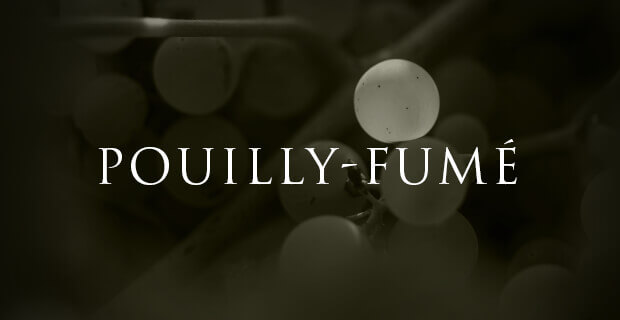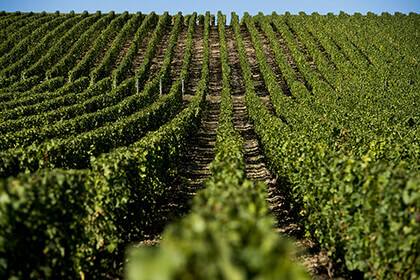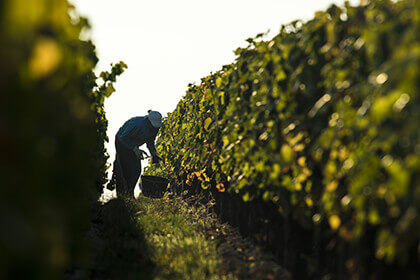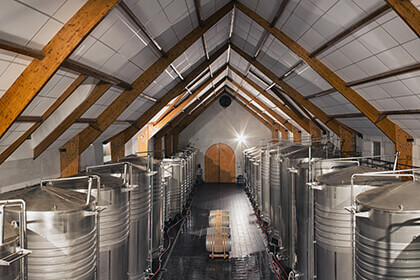Pouilly-Fume Wines
The origins of the vineyards in Pouilly Fumé date back to the Gallo-Roman times. But it was only much later that the appelation has seen a real expansion, thanks to religious congregations including...Read More
















The Classic Timelessness of Pouilly-Fumé’s Sauvignon Blanc

Pouilly-Fumé with its picturesque rolling chalk hills is the land of Sauvignon Blanc on the right bank of the Loire River. With its 1,200 hectares, the appellation centres around the charming villages of Saint-Andelain and Les Loges on a south-west facing slope. The Kimmeridgian marls and calcareous rock sprinkled with flecks of flint allow Sauvignon Blanc to develop unrivalled complexity and an inimitable style underscored with its universally-acclaimed gun flinty mineral character. The fresh, lively fruit flavours range from sunny citrus to radiant tropical notes and complement its grassy personality. Though Sancerre is a neighbouring rival, the exquisite expressiveness of Pouilly-Fumé wines are for all those who appreciate and yearn for the classic timelessness of Sauvignon Blanc.
All About the Name
One of the most acclaimed white wines from the Loire Valley is none other than Pouilly-Fumé, the dry white wine from Sauvignon Blanc grapes. Pronounced as POO-ee foo-MAY, be careful not to get it confused with Pouilly-Fuissé (articulated as POO-ee foo -SAY) in Burgundy’s Mâconnais region that specialises in Chardonnay. It hails from the far eastern flank of the region, and is just across the river on the right bank from its rival Sancerre. However, unlike Sancerre, Pouilly-Fumé dedicates all of its production to white wine. As you can tell, the name consists of two parts: “Pouilly” is short for Pouilly-sur-Loire, and this is the village where the wine comes from. “Fumé” is short for Blanc Fumé, and this is the local nickname for the Sauvignon Blanc variety.
The fumé in Blanc Fumé is “smoky” in French, and it actually has three different connotations: one associated with the grape, another connected to the soil, and the last one linked to the fog. The Sauvignon Blanc variety has egg-shaped berries in tight clusters. As they mature, a thin smoke-coloured film, or grey bloom, covers the berries. The wine growers refer to this as Blanc fumé, or smoked white, and use the expression to describe the variety. The term fumé also refers to the appellation’s universally-recognised gunflint aroma. It’s such a source of pride that even one of the appellation’s top winemakers, Didier Dagueneau, named one of his top wines “Silex” – a synonym for flint. Many believe this aroma comes from that flint that is scattered throughout the appellation. Lastly, fumé also refers to the fog that blankets the Loire Valley in the early mornings.

From the Benedictines to Phylloxera to Global Success
The Pouilly-Fumé vineyards appeared all the way back in the fifth century during the Gallo-Roman times. However, it wasn’t until the Benedictine monks came along during the Middle Ages when they started to expand the vineyards and make it more of a commercial success. Since they had no family or personal commitments, they could devote their time in the vineyards when their religious duties had finished for the day. The vineyards proximity to the Loire River also contributed to the area’s prosperity since the wines could get to market relatively easier through navigating them along the river. With the opening of the Briare Canal in 1642, Pouilly-Fumé’s wine trade further expanded since the canal linked up the Loire and Seine Rivers meaning that more trade was directed towards Paris where aristocrats and the upper middle-classes enjoyed sipping those aromatic whites.
Pouilly-Fumé was blessed with this prosperity until the late nineteenth century before hard times hit the vineyards. In 1888, mildew invaded the vineyards and just as wine growers figured out how to treat it, the dreaded phylloxera showed up and started feasting upon the roots and leaves of Pouilly-Fumé’s treasured vines in 1890. After a tireless effort to get rid of the pest, wine growers had no choice but to surrender once phylloxera had devastated their vineyards. The vines had to be uprooted in the next decade, and replanted after they had been grafted onto American rootstocks. Interestingly, the reason why Sauvignon Blanc now dominates the appellation is because the variety was much more responsive to grafting than the red varieties Gamay and Pinot Noir that had been widely planted on the slopes prior to the onslaught of phylloxera. Nonetheless, Pouilly-Fumé quickly regained its former reputation once the delimitation of its production area was determined in 1929, and its AOC status confirmed in 1937. The 1970s and 1980s saw Pouilly-Fumé’s popularity skyrocket, and this led to more vineyard area devoted to the appellation’s superstar Sauvignon Blanc. Since then, Pouilly-Fumé continues to ride this wave of success in spite of its rivalry with neighbouring Sancerre.

The Smoking Gunflint Terroir
The Pouilly-Fumé vineyards span across eight communes in the vicinity of Pouilly-sur-Loire on the right bank of the Loire River. The appellation got its AOC status in 1937 originally as “Blanc Fumé de Pouilly”. Compared to the western part of the region, Pouilly-Fumé has more of a cool continental climate since it’s quite far from the Atlantic Ocean. Summers are therefore short and hot while winters are long and cold. These cooler conditions mean that the vineyards are at risk of spring frost. However, the Loire River helps mitigate the effects of those extreme continental temperatures so that the vines can flourish in the appellation. To discover what makes Pouilly-Fumé wines so distinct, you need to take a look underneath the vineyards. Here, you can find four different types of soil that impart a variety of profiles on the wines. The Villiers and Barrois limestone soils, known as “caillottes”, give beautifully fresh, sharp wines that are ready to drink, especially if they come from young vines. The second type consists of marl with oyster shell deposits, known as “terre blanches”, and it produces crisp wines with fruity, floral notes and hints of smoke. These wines have excellent cellaring potential. The next one is a flint soil that makes wines abounding with spice and minerality – this minerality is the appellation’s revered gunflint aroma. It’s best to cellar these wines for at least one to two years so that they can develop their flavours. The last type is a clay-flint soil, and these wines vary depending on the sand-clay proportions. Those with more sand are soft and supple while those with more clay are livelier.
Like in Sancerre, the harvest starts as the autumn colours blanket the appellation at the end of September and the start of October. For the vineyards rooted on Pouilly-Fumé’s steeper slopes, the vineyards teams have the strenuous task of hand-harvesting. However, for the flatter areas in the appellation, mechanical harvesting is more common since it saves time and money. After the grapes are plucked from the vines at their perfect ripeness, the winemaker then starts the task of realizing the vintage’s best expression of the variety.

Pouilly-Fumé Estates: An Ode to Sauvignon Blanc’s Flintiness
Two of the most celebrated estates creating Sauvignon Blanc belong to the Mellot family who represent not just Pouilly-Fumé, but other appellations throughout the Loire region. The first mention of the Mellot family as vine growers and wine merchants were in local records in 1513. Since then, the Alphonse Mellot estate has been passed down for generations from father to son with the eldest son carrying on the name of the founder. Alphonse Mellot and his son work as a team to the making traditions of centuries past to create exceptionally exquisite wines in Sancerre from both Sauvignon Blanc and Pinot Noir. Domaine Joseph Mellot is another distinguished estate with links to the Mellot family. Joseph Mellot had run the Alphonse Mellot family estate with his brother Edmond since 1946, but he decided to branch out and establish his own venture in 1969. Catherine Corbeau Mellot now heads the domaine, and it’s an ambassador for all of the eight Centre-Loire Valley appellations. For the cuvées from Pouilly-Fumé, they’re of great finesse, elegance and complexity enveloped in citrus and exotic fruit notes. You can find expressions that are aged in stainless steel tanks or those that have been through fermentation and ageing in oak barrels. Nevertheless, your palate is met with Sauvignon Blanc’s signature crispy, biting acidity and aromatic persistence.

Domaine Pascal Jolivet is another remarkable Pouilly-Fumé estate that dates back to 1926 when the Jolivet family entered the world of wine. Pascal Joliet runs the estate under his own name with help from his talented Italian oenologist, Valentina Buoso. For Joliet, Sauvignon Blanc is all about balance, freshness and precision, so he strives to amplify the purity of the fruit and the most authentic expression of the terroir with the use of indigenous yeasts. This results in dazzling wines that have finesse from limestone, richness from limestone-clay, and structure with minerality from flint. Full-bodied richness is what you can expect from every single sip of a Pascal Jolivet Pouilly-Fumé wine. Last but not least, the acclaimed Château de Tracy is another Pouilly-Fumé emissary that offers some of the best expressions of Sauvignon Blanc. These vineyards have produced complex and diversely-styled wines since 1396, but the estate’s current embodiment is due to the efforts of the Count and Countess Alain d’Estutt d’Assay who restored the château to its former glory in 1952. Today, Henry d’Assay, the son, heads the 33-hecatre domaine. These richly complex wines often reveal a variety of floral aromas that can include boxwood, broom and lily-of-the-valley, as well as a sunny bouquet of citrus and tropical fruit notes underpinned with green pepper and vanilla spicy hints.
With all of its dazzling fruit and nervy acidity, Pouilly-Fumé wines lures those who enjoy the classic timelessness of Sauvignon Blanc. Before you even take the very last sip of one of these brilliantly textured wines, you’ll already be yearning for your next Pouilly-Fumé encounter.